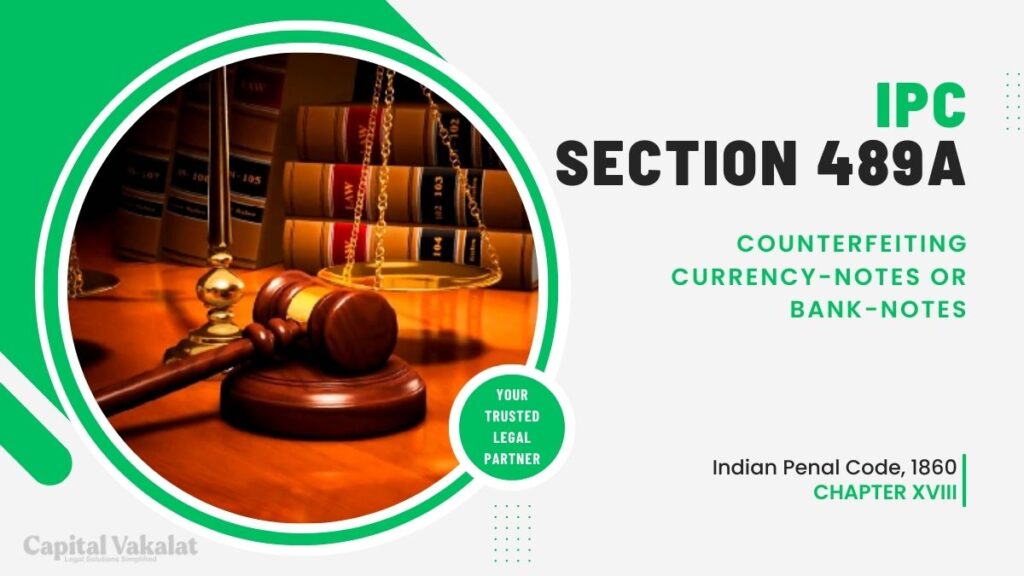In the intricate tapestry of legal statutes in India, Section 489A of the Indian Penal Code (IPC) stands out as a formidable safeguard against a pervasive threat – the counterfeiting of currency-notes or bank-notes. Let’s delve into the depths of this section, exploring its nuances, historical roots, legal implications, and the broader global context surrounding the issue.

Counterfeiting, a term that echoes through the corridors of financial security, refers to the illicit replication of currency. In the Indian legal framework, Section 489A of the IPC plays a pivotal role in addressing this menace. This section holds particular significance in preserving the sanctity of the nation’s currency and maintaining economic stability.
Understanding Counterfeiting
To comprehend the gravity of Section 489A, one must first understand the art of counterfeiting itself. This deceptive practice has a long history, dating back to the times when currencies were physical representations of a nation’s wealth. Counterfeiters, then and now, pose a threat to the very foundation of economic systems, compromising the trust in the currency’s authenticity.
Overview of Section 489A IPC
At its core, Section 489A is a legal bulwark designed to thwart the nefarious activities of counterfeiters. It explicitly outlines what constitutes an offense and the legal repercussions that follow. The language of the section is crafted with precision, encompassing a range of actions related to the creation, distribution, and use of fake currency.
Penalties and Punishments
The severity of penalties outlined in Section 489A underscores the government’s commitment to eradicating counterfeiting. Offenders face not only imprisonment but also fines, with the quantum of punishment varying based on the gravity of the offense. This robust legal framework acts as a deterrent, discouraging potential counterfeiters from engaging in such activities.
Cases and Precedents
Examining past cases provides a glimpse into the real-world impact of Section 489A. Notable legal battles have shaped the interpretation of this section, setting precedents that guide the judicial system in dealing with counterfeit currency cases. These cases serve as cautionary tales, illustrating the consequences for those who attempt to undermine the stability of the nation’s economy.
Measures to Combat Counterfeiting
In the ever-evolving landscape of technology, the fight against counterfeiting extends beyond legal frameworks. Governments worldwide, including India, have embraced technological innovations to secure their currency. From intricate watermarking to holographic strips, these measures not only deter counterfeiters but also enhance the public’s trust in the currency.
Role of Law Enforcement
Law enforcement agencies play a crucial role in implementing Section 489A. Through specialized units and collaborations with international organizations, these agencies employ cutting-edge techniques to identify and apprehend counterfeiters. The synergy between legal provisions and enforcement efforts forms a robust defense against the illicit circulation of fake currency.
Global Perspectives on Counterfeiting
A comparative analysis of Section 489A with similar laws in other countries sheds light on the global effort to combat counterfeiting. International collaborations, such as INTERPOL’s initiatives, highlight the interconnected nature of this issue. Understanding how other nations address counterfeit currency contributes to a comprehensive strategy in safeguarding economic systems.
Challenges and Issues
Despite the effectiveness of Section 489A, challenges persist. Implementation hurdles, lack of public awareness, and the constant evolution of counterfeiting techniques pose ongoing threats. Addressing these issues requires a multi-faceted approach, involving legislative amendments, educational campaigns, and technological innovations.
Conclusion
In conclusion, Section 489A of the IPC stands as a stalwart guardian of economic stability, deterring those who seek to undermine the integrity of currency. As we navigate the complexities of counterfeiting, it is imperative to appreciate the symbiotic relationship between legal provisions, law enforcement efforts, and technological advancements. Section 489A serves as a beacon, guiding the nation towards a future where the authenticity of currency is sacrosanct.
Frequently Asked Questions
How can individuals identify counterfeit currency?
Government authorities often release guidelines on identifying genuine currency. Common signs include watermarks, security threads, and specific features unique to each denomination. Regularly staying updated on these features is essential.
Are there international efforts to combat global counterfeiting?
Yes, organizations like INTERPOL and collaborative initiatives among nations aim to combat counterfeiting on a global scale. The exchange of information and joint operations contribute to a unified front against this criminal activity.
What role do financial institutions play in preventing the circulation of counterfeit currency?
Financial institutions collaborate with law enforcement agencies and employ advanced technologies to detect counterfeit currency during transactions. Reporting suspicious activities is also a crucial part of their role in combating counterfeiting.
How can public awareness contribute to the effectiveness of Section 489A?
Public awareness campaigns play a vital role in educating citizens about the consequences of counterfeiting and how to identify fake currency. An informed public acts as an additional layer of defense against the circulation of counterfeit notes.